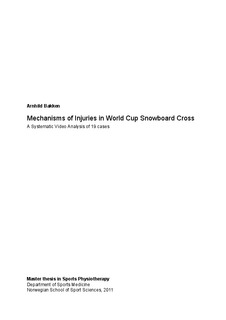Mechanisms of injuries in World Cup Snowboard Cross: a systematic video analysis of 19 cases
Master thesis
Permanent lenke
http://hdl.handle.net/11250/171691Utgivelsesdato
2011Metadata
Vis full innførselSamlinger
Sammendrag
Background: Snowboard Cross became an official Olympic sport in 2006. This discipline
includes manoeuvring several obstacles while competing in heats. It is common for the riders
to collide, making this sport both exciting and at risk for injuries. Although a recent study
from the 2010 Olympic Games showed that the injury risk was high, little is known about the
injury mechanisms.
Objective: To qualitatively describe the injury situation and mechanism of injuries in World
Cup snowboard cross.
Study design: Descriptive video analysis.
Methods: Nineteen video recordings of snowboard cross injuries reported through the
International Ski Federation Injury Surveillance System for 4 World Cup seasons (2006-
2010) were obtained. Five experts in the field of sports medicine, snowboard and
biomechanics performed analyses of each case to describe the injury mechanism in detail
(riding situation and rider behaviour).
Results: Injuries occurred at jumping (n=13), bank turning (n=5) or rollers (n=1). The
primary cause of the injuries was a technical error at take-off resulting in a too high jump and
subsequent flat landing. The rider was then unable to recover leading to fall at the time of
injury. Injuries at bank turn was characterised by a pattern where the rider in a balanced
position lost control due to unintentional contact with another rider.
Conclusion: Jumping appeared to be the most challenging obstacle in snowboard cross,
where a technical error at take-off was the primary cause of the injuries. The second most
common inciting event was unintentional board contact between riders at bank turning.
Keywords: Snowboard Cross, Snowboarding injuries, injury mechanism, jumping, video
analysis.
Beskrivelse
Masteroppgave - Norges idrettshøgskole, 2011
